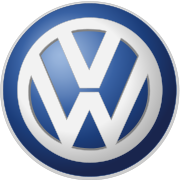Volkswagon
- Volkswagen
- Industry Automotive
- Founded 28 May 1937
- Founder(s) Ferdinand Porsche
- Headquarters Wolfsburg, Germany
- Area served Worldwide
- Key people Martin Winterkorn:
- Chairman of the Board of Management,
- Ferdinand Piëch: Chairman of Volkswagen Supervisory Board
- Products Cars
- Production output increase4,591,851 units (2010)
- Revenue increase€80.251 billion (2010)
- (US$119 billion USD)
- Employees 368,500 (2009)
- Parent Volkswagen Group
- Website www.volkswagen.com
- Volkswagen (abbreviated VW) is a German automobile manufacturer and is the original and biggest-selling marque of the Volkswagen Group, which now also owns the Audi, Bentley, Bugatti, Lamborghini, SEAT, 49.9% of Porsche, and Škoda marques and the truck manufacturer Scania.
- Volkswagen means "people's car" in German, where it is pronounced [ˈfɔlksˌvaːɡən]. Its current tagline or slogan is Das Auto (The Car)
- Volkswagen was originally founded in 1937 by the Nazi trade union, the German Labour Front (Deutsche Arbeitsfront). In the early 1930s German auto industry was still largely composed of luxury models, and the average German rarely could afford anything more than a motorcycle. As a result only one German out of 50 owned a car. Seeking a potential new market, some car makers began independent "peoples' car" projects – Mercedes' 170H, Adler's AutoBahn, Steyr 55, Hanomag 1,3L, among others.
- The trend was not new, as Béla Barényi is credited with having conceived the basic design in the middle 1920s. Josef Ganz developed the Standard Superior (going as far as advertising it as the "German Volkswagen").[broken citation] Also, in Czechoslovakia, the Hans Ledwinka's penned Tatra T77, a very popular car amongst the German elite, was becoming smaller and more affordable at each revision. In 1933, with many of the above projects still in development or early stages of production, Adolf Hitler got involved, demanding the production of a basic vehicle capable of transporting two adults and three children at 100 km/h (62 mph). The "People's Car" would be available to citizens of the Third Reich through a savings scheme at 990 Reichsmark (US$396 in 1930s dollars)--about the price of a small motorcycle (an average income being around 32RM a week).
- Despite heavy lobbying in favour of one of the existing projects, it soon became apparent that private industry could not turn out a car for only 990RM. Thus, Hitler chose to sponsor an all-new, state-owned factory. The famed Austrian engineer Ferdinand Porsche supervised design of the car, but Hitler himself took a hand in the planning. Changes included better fuel efficiency, reliability, ease of use, and economically efficient repairs and parts. The intention was that ordinary Germans would buy the car by means of a savings scheme ("Fünf Mark die Woche musst du sparen, willst du im eigenen Wagen fahren" – "Five Marks a week you must put aside, If in your own car you want to ride"), which around 336,000 people eventually paid into. Prototypes of the car called the "KdF-Wagen" (German: Kraft durch Freude – "strength through joy"), appeared from 1936 onwards (the first cars had been produced in Stuttgart). The car already had its distinctive round shape and air-cooled, flat-four, rear-mounted engine. The VW car was just one of many KdF programs which included things such as tours and outings. The prefix Volks— ("People's") was not just applied to cars, but also to other products in Europe; the "Volksempfänger" radio receiver for instance. On 28 May 1937, the Gesellschaft zur Vorbereitung des Deutschen Volkswagens mbH (sometimes abbreviated to Gezuvor[6]) was established by the Deutsche Arbeitsfront. It was later renamed "Volkswagenwerk GmbH" on 16 September 1938.

